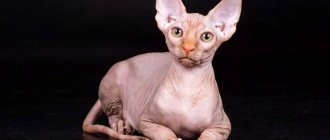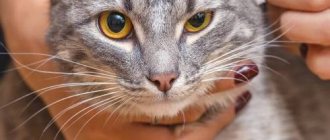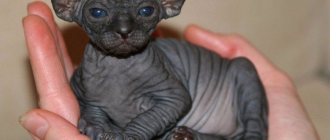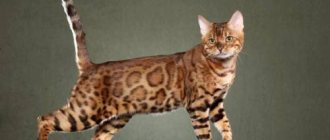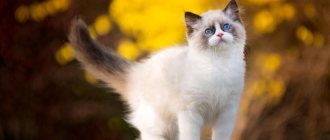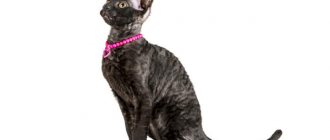No wool. With folds on the skin. Pot-bellied. With locator ears. With huge eyes... But still, this is a real cat. Someone will say: “The Canadian Sphynx is a freak!” But those who were lucky enough to get to know this amazing creature better consider the “moon cat” to be the most beautiful, charming, intelligent and loving creature in the world.
Hairless cats can be treated differently. However, due to their non-standard appearance, there is always increased interest in them. It is impossible not to notice, not to talk about them. Where did this unique breed come from and why is it considered one of the elite of the cat world?
History of the breed
According to some sources, cats without fur lived back in the times of the Aztecs. However, the first accurate confirmations appeared in the last century. Then, at exhibitions in the United States, a special breed was demonstrated - the Mexican Hairless, whose representatives, unfortunately, never acquired offspring, which is why this species simply disappeared. Judging by the description, they had significant differences from modern sphinxes: the body was quite long, the head had a wedge-shaped head, the eyes had a bright amber hue, and there were mustaches on the muzzle, which are not found in modern breeds. By winter, hair grew on their back and tail, which disappeared by summer.
The genetic code of these four-legged animals was never solved, so the breed sank into oblivion. However, in 1966, a furless kitten was born in Canada and was named Prune. As soon as he grew up, they began to cross him with his “relatives” in order to preserve the original genetic chain. However, attempts to develop a new breed failed because the genes turned out to be very unstable and kittens with fur still appeared in the litter. In addition, hairless kittens required special care, without which they quickly died.
However, 10 years later the decision came by itself, when a hairless cat named Epidermis was born in one of the American nurseries. A year later, a cat was born in the same place, who became the “bride” of Epidermis. It was thanks to them that breeders finally managed to breed sphinxes.
In our country, the first Canadian Sphynxes appeared in the early 2000s, but it is impossible to say that it was then that the first hairless cats were brought to Russia. The fact is that in 1987, a kitten was found on the street of Rostov-on-Don, which was completely missing hair. No, don’t think about it - it was not an illness. It turns out that he, like his Canadian counterparts, had a mutation due to which there was not a hair on his body. Subsequently, this breed received the name Don Sphynx, so the appearance of hairless Canadian cats was no longer something unusual and outlandish for Russians.
And already in 1994, in St. Petersburg, breeders decided to cross an Oriental cat with the Don Sphynx, thanks to which hairless Orientals were born - the Peterbald.
What is an animal
The Canadian Sphynx is good-natured, peaceful, intelligent, has an excellent memory, is very well trained, playful: if he is not occupied with anything, he will start playing pranks to get rid of boredom.
These cats are extremely loving and affectionate: they do not tolerate loneliness well (they fall into depression, become withdrawn and even aggressive), they love their owner very much: when he is at home, they follow him on his heels, ask to be held and, if allowed, sleep with pleasure next to him on the bed.
They sense the mood of their owner very well, and if they see that he is out of sorts or ill, they do not leave his side and try to cheer him up with affection and purring.
Does the Canadian Sphynx have a mustache? Differences between breeds
In fact, these are not just protruding antennae, but a very important organ of touch. With their help, cats can navigate space very well at night.
Catching air currents with its whiskers, the cat recreates a picture of the environment in its mind, which is vitally important when hunting and climbing trees and thorny bushes.
If you touch the whiskers, the cat reflexively closes its eyes. After all, in place of your finger there could be some kind of thorny branch in the bush. This mustache is a protective mechanism and a means of navigation.
Why do cats need mustaches?
A cat's whiskers are sensory organs. Their correct name is vibrissae. Translated from Latin, this word means “to wriggle, waver.” With the help of whiskers, the cat receives additional information about the space around it.
The structure of the mustache is similar to ordinary hair, but it is thicker, stiffer, longer and “set” much deeper. If you look closely at any cat, you will find that “whiskers” grow on its cheeks, chin, eyebrows, and even on its front legs and tail.
Each vibrissa hair has an individual neural connection with the brain. They transmit data about the distance to nearby objects and record temperature changes. Whiskers help cats navigate in space, catch the movements of the prey, and accurately calculate the trajectory of the jump. With their help, the animal navigates in complete darkness.
The importance of vibrissae was confirmed during inhumane experiments to remove them.
Cats without whiskers felt worse:
- were clearly disoriented;
- their coordination of movements was impaired;
- could not correctly calculate the distance during a jump;
- “saw” worse in the dark;
- showed clear signs of stress.
For a domestic animal, the temporary loss of a mustache is not as tragic as for a free one. The life of a street cat depends on the ability to accurately navigate in space: to track and catch prey, to defeat an enemy in a fight, to run away and hide from the enemy.
What do sphinxes look like?
Hairless Sphynx cats come in two breeds: Don and Canadian. The first appeared at the end of the last century in Rostov-on-Don. The second - in the second half of the twentieth century in Canada. In both cases, breeders noticed an unusual species of animal and made considerable efforts to preserve it.
Canadian Sphynx. Photo:
The breeds are similar in appearance, but genetically they are different, and crossbreeding between them is prohibited. Sphynx cats have a recessive gene, so both parents must have it to produce hairless offspring. With the Don, things are different. These sphinxes have a dominant gene, so even if one of the parents is furry, the offspring will inherit hairlessness.
Don Sphynx. Photo:
Sphinxes look quite unusual. Their main feature is the absence of hair on their body. Although Don cats are different:
- naked (rubber), that is, hairless;
- flock - similar to a peach to the touch, the fur is almost invisible, and usually disappears completely with age;
- velor - wool length does not exceed 3 mm;
- brush - the coat is hard, and there may be bald patches on the neck and head.
As for Canadians, their body can be covered with a thin, soft and barely noticeable fluff that grows on the face, ears, tail and paws.
The skin of sphinxes is soft and elastic, and gathers in folds on the neck, paws, tail and belly. It feels warm and pleasant to the touch. And the normal body temperature of these cats is higher than that of representatives of other breeds.
Many people believe that because of their main feature, hairless cats are hypoallergenic. But this is a misconception. Don and Canadian Sphynxes can cause allergies, since the human body reacts not only to fur, but also, for example, to saliva and skin secretions.
Find out more




